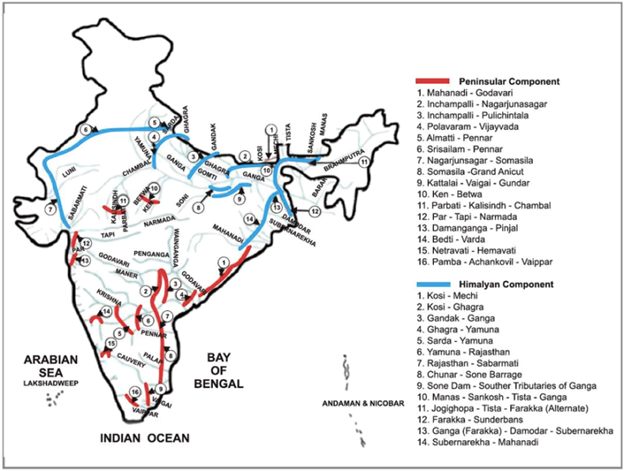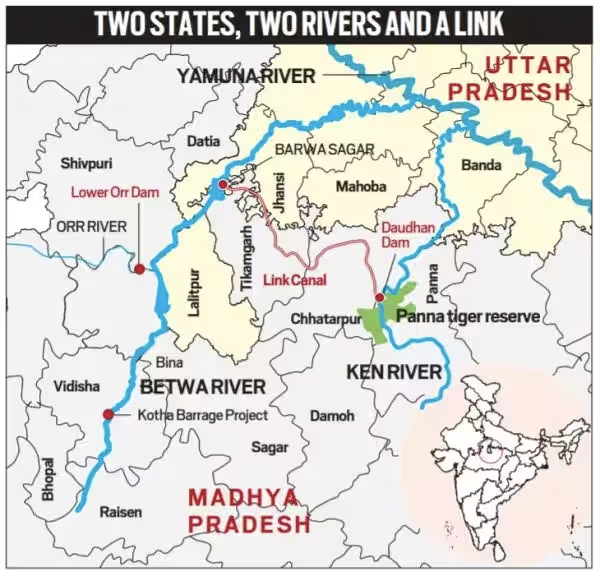Ken-Betwa Link Project.
Relevance
- GS Paper 1 Water Resources.
- GS Paper 2 Inter-State Relations.
- Tags: #Ken Betwa Link Project, #National Perspective Plan, #Ken and Betwa Rivers.
Why in the news?
A memorandum of agreement was signed between the Union Minister of Jal Shakti and the chief ministers of Madhya Pradesh and Uttar Pradesh to implement the Ken-Betwa Link Project (KBLP). The agreement was signed through a video conference in the presence of Prime Minister Narendra Modi.
What is the Ken Betwa Link Project?
- The Ken-Betwa Link Project is the first project under the National Perspective Plan for interlinking of rivers. Under this project, water from the Ken river will be transferred to the Betwa river. Both these rivers are tributaries of river Yamuna.
The Ken-Betwa Link Project has two phases
- Under Phase-I, one of the components — Daudhan dam complex and its appurtenances like Low Level Tunnel, High Level Tunnel, Ken-Betwa link canal and Power houses — will be completed.
- While in the Phase-II, three components — Lower Orr dam, Bina complex project and Kotha barrage — will be constructed.
National Perspective Plan (NPP)
- The National Perspective Plan (NPP) for Water Resources Development was formulated by the Government of India in 1980. The NPP comprises of two components, viz; Peninsular Rivers Development Component and Himalayan Rivers Development Component.
Salient features of the two components are given at Annexure
- Under the two components of NPP, a total of 30 link projects have been identified; 14 link projects under Himalayan Rivers Development Component and 16 link projects under Peninsular Rivers Development Component.
- National Water Development Agency (NWDA) has been entrusted with the work of Interlinking of Rivers under the NPP.
- Out of 30 identified link projects under the NPP, Pre-Feasibility Reports (PFRs) of all the 30 links have been completed, while Feasibility Reports (FRs) of 24 links and Detailed Project Reports (DPRs) of 8 links have also been completed.
Peninsular Rivers Development Component: The scheme is divided into four major parts.
- Interlinking of Mahanadi-Godavari-Krishna-Pennar Cauvery rivers and building storages at potential sites in these basins. This part involves interlinking of the major river systems where surplus from the Mahanadi and the Godavari are intended to be transferred to the needy areas in the south, through Krishna, Pennar and Cauvery rivers.
- Interlinking of west flowing rivers, north of Bombay and south of Tapi : The scheme provides for taking water supply canal to the metropolitan areas of Mumbai; it also provides irrigation in the coastal areas in Maharashtra.
- Interlinking of Ken-Chambal: The scheme provides for a water grid for Madhya Pradesh, Rajasthan and Uttar Pradesh and interlinking canal backed by as many storages as possible.
- Diversion of other west flowing rivers: The high rainfall on the western side of the “Western Ghats” runs down into numerous streams which discharge into the Arabian Sea. The construction of an interlinking canal system backed up by adequate storages could be planned to meet requirements of new areas on the western side as also for transfer of some waters towards east to meet the needs of drought affected areas.
Himalayan Rivers Development Component
- The Himalayan Rivers Development Component envisages construction of storages on the principal tributaries of Ganga and the Brahmaputra in India, Nepal and Bhutan along with interlinking canal systems to transfer surplus flows of the eastern tributaries of the Ganga to the West, apart from linking of the main Brahmaputra and its tributaries with the Ganga and Ganga with Mahanadi and further south.
Previous examples of river-linking in India
- In the past, several river linking projects have been taken up. For instance, under the Periyar Project, transfer of water from Periyar basin to Vaigai basin was envisaged.
- It was commissioned in 1895. Similarly, other projects such as Parambikulam Aliyar, Kurnool Cudappah Canal, Telugu Ganga Project, and Ravi-Beas-Sutlej were undertaken.
Ken and Betwa Rivers
- Ken and Betwa rivers originate in MP and are the tributaries of Yamuna.
- Ken meets with Yamuna in Banda district of UP and with Betwa in Hamirpur district of UP.
- Rajghat, Paricha and Matatila dams are over Betwa river.
- Ken River passes through Panna tiger reserve.
Advantage of Interlining of Rivers
- Reducing Drought: River linking will be a solution to recurring droughts in Bundelkhand region.
- Farmers’ Benefit: It will curb the rate of farmers suicide and will ensure them stable livelihood by providing sustainable means of irrigation and reducing excessive dependence on groundwater.
- Electricity Production: It will not only accelerate the water conservation by construction of a multipurpose dam but will also produce 103 MW of hydropower and will supply drinking water to 62 lakh people.
- Rejuvenate Biodiversity: Few are of the view that the introduction of dams inside the water scarce regions of panna tiger reserve (MP), will rejuvenate the forests of the reserve that in turn will pave the way for Rich Biodiversity in the region.
Issues
- Environmental: Because of certain environmental and wildlife conservation concerns like passing of the project though critical tiger habitat of panna tiger reserve, the project is stuck in for the approval from National Green Tribunal (NGT), and other higher authorities.
- Economic: There is a huge economic cost attached with the project implementation and maintenance, which has been rising due to delays in project implementation.
- Social: Reconstruction and rehabilitation caused due to displacement resulting from the implementation of the project will involve social cost as well.
Source: The Hindu
Mains Question
Discuss the significance and challenges of the Ken-Betwa Interlinking project.





